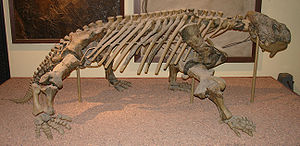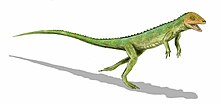Parareptiles
| Parareptiles | ||||||||||||
|---|---|---|---|---|---|---|---|---|---|---|---|---|

Skeletal reconstruction of Bradysaurus |
||||||||||||
| Temporal occurrence | ||||||||||||
| Upper Carboniferous to Upper Triassic | ||||||||||||
| 303.7 to 208.5 million years | ||||||||||||
| Locations | ||||||||||||
|
||||||||||||
| Systematics | ||||||||||||
|
||||||||||||
| Scientific name | ||||||||||||
| Parareptilia | ||||||||||||
| Olson , 1947 |
Parareptiles are an extinct group of reptiles that arose from a first diversification of the higher terrestrial vertebrates in the early Upper Carboniferous , but with the genus Erpetonyx is only documented by fossil finds from the most recent Upper Carboniferous and survived with the Procolophonids until the end of the Triassic .
In tribal history , parareptiles are defined as the least exclusive community of descent to which Milleretta rubidgei and Procolophon trigoniceps belong, but not Captorhinus aguti (see Tsuji and Müller, 2009). The sister group of the parareptiles are the eureptiles , to which the groups of scale reptiles , crocodiles and birds that live today also belong. The position of the tortoises (Testudinata) in the reptile system is uncertain.
features

Diagnostic features of parareptiles are (according to Müller and Tsuji 2007; Tsuji and Müller 2009), among other things , the lack of contact between the lacrimal and the nasal opening, the lack of a canine region , a single, centrally located indentation on the posterior edge of the cranium, and the lack of a supra glenoid opening , the lack of a subtemporal process on the jugal , the firm contact of the prefrontal to the palatine , a square jugal that is elongated on the abdomen , and the position of the temporomandibular joint at the level of the occiput or a little behind it.
The parareptiles are very diverse and include both the aquatic mesosaurs and fully terrestrial groups such as the massively built pareiasaurs and the lizard-like bolosaurids , milerettids , " nycteroleterids " and procolophonoids . While some groups such as the Millerettidae were probably insectivores (larger "Nycteroleteridae" such as Macroleter , probably even carnivores) and the mesosaurs ate fish and aquatic arthropods , bolosaurids, procolophonoids and pareiasaurs are interpreted as herbivores due to their teeth (see Benton 2005, Pp. 113-118).
Family relationships




The following cladogram shows the relationships of the parareptiles according to Tsuji and Müller (2009). The subdivision of the eureptiles follows Laurin and Reisz (1995) (see also Benton, 2005).
| Amniota |
|
|||||||||||||||||||||||||||||||||||||||||||||||||||||||||||||||||||||
|
|
The group of reptiles (Reptilia) includes, according to the definition of Modesto and Anderson (2004), today's reptile groups and all animals that are more closely related to them than to mammals. Synonymous with Reptilia , Sauropsida is also used as a group name. The position of Eunotosaurus next to the Milleretidae is uncertain, osteological findings indicate a closer relationship with the turtles , which have generally been known as diapsids (and thus eureptiles) since 2010 at the latest .
Ancestral group of turtles?
The anatomy of the turtles, which differs significantly from other reptile groups today , including the anapsid skull, i. H. a skull without temporal openings gave and still gives cause for some paleontologists to believe that these special features are due to an early separation of the trunk lines of the tortoises and the diapsids living today and that the parareptiles are the closest fossil relatives of the tortoises . Procolophonids (Laurin and Reisz, 1995) as well as pareiasaurs (see e.g. Lee 1997) and more recently Eunotosaurus (Lyson et al., 2010) were previously considered possible parareptile sister groups of the turtles .
For the corresponding clade (parareptiles including turtles) the name Anapsida was meanwhile in use (Modesto, 1999).
It is doubtful that osteological similarities that point to a relationship between the turtles and the parareptiles actually represent homologous features (see Rieppel and Reisz 1999; Rieppel 2000) and particularly molecular biological findings point to a position of the turtles within the diapsids (Zardoya and Meyer 1998, Cao et al. 2000). In addition, there is hardly any bone histological correspondence between the skin bone plates ( osteoderms ) of the pareiasaurs and the turtle shells , which histologically resemble the skin ossification of the diapsids (Scheyer and Sander 2009).
literature
- Michael J. Benton : Vertebrate Paleontology. 3. Edition. Blackwell, Malden MA 2005, ISBN 0-632-05637-1 .
- Ying Cao, Michael D. Sorenson, Yoshinori Kumazawa, David P. Mindell, Masami Hasegawa: Phylogenetic position of turtles among amniotes: evidence from mitochondrial and nuclear genes. In: Genes. Vol. 259, 2000, ISSN 0378-1119 , pp. 139-148, doi : 10.1016 / S0378-1119 (00) 00425-X .
- Michel Laurin, Robert R. Reisz: A reevaluation of early amniote phylogeny. In: Zoological Journal of the Linnean Society. Vol. 113, No. 2, 1995, ISSN 0024-4082 , pp. 165-223, doi : 10.1111 / j.1096-3642.1995.tb00932.x .
- Michael SY Lee: A taxonomic revision of pareiasaurian reptiles: implications for Permian terrestrial paleoecology. In: Modern Geology. Vol. 21, No. 3, 1997, ISSN 0026-7775 , pp. 231-298.
- Tyler R. Lyson, Gabe S. Bever, Bhart-Anjan S. Bhullar, Walter G. Joyce, Jacques A. Gauthier : Transitional fossils and the origin of turtles. In: Biology Letters. Vol. 6, No. 6, 2010, ISSN 1744-9561 , pp. 830-833, doi : 10.1098 / rsbl.2010.0371 .
- Sean P. Modesto, Jason S. Anderson: The phylogenetic definition of Reptilia. In: Systematic Biology. Vol. 53, No. 5, 2004, ISSN 1063-5157 , pp. 815-821, doi : 10.1080 / 10635150490503026 .
- Sean P. Modesto: Observations on the Structure of the early Permian Reptile Stereosternum tumidum Cope. In: Palaeontologia Africana. Vol. 35, 1999, ISSN 0078-8554 , pp. 7-19.
- Johannes Müller, Linda A. Tsuji: Impedance-matching hearing in Paleozoic reptiles: evidence of advanced sensory perception at an early stage of amniote evolution. In: PLoS ONE . Vol. 2, No. 9, 2007, e889, doi : 10.1371 / journal.pone.0000889 .
- Everett Claire Olson : The family Diadectidae and its bearing on the classification of reptiles (= Fieldiana. Geology. Vol. 11, No. 1, ISSN 0096-2651 ). Chicago Natural History Museum, Chicago IL 1947.
- Olivier Rieppel , Robert R. Reisz: The origin and early evolution of turtles. In: Annual Review of Ecology and Systematics. Vol. 30, 1999, ISSN 0066-4162 , pp. 1-22, doi : 10.1146 / annurev.ecolsys.30.1.1 .
- Olivier Rieppel: Turtles as diapsid reptiles. In: Zoologica Scripta. Vol. 29, No. 3, 2000, ISSN 0300-3256 , pp. 199-212, doi : 10.1046 / j.1463-6409.2000.00039.x .
- Linda A. Tsuji, Johannes Müller: Assembling the history of the Parareptilia: phylogeny, diversification, and a new definition of the clade. In: Fossil Record. Vol. 12, No. 1, 2009, ISSN 2193-0066 , pp. 71-81, doi : 10.1002 / mmng.200800011 .
- Torsten M. Scheyer, P. Martin Sander : Bone microstructures and mode of skeletogenesis in osteoderms of three pareiasaur taxa from the Permian of South Africa. In: Journal of Evolutionary Biology. Vol. 22, No. 6, 2009, ISSN 1010-061X , pp. 1153-1162, doi : 10.1111 / j.1420-9101.2009.01732.x .
- Rafael Zardoya, Axel Meyer : Complete mitochondrial genome suggests diapsid affinity of turtles. In: Proceedings of the National Academy of Sciences of the United States of America . Vol. 95, No. 24, 1998, pp. 14226-14231, doi : 10.1073 / pnas.95.24.14226 .
Web links
Individual evidence
- ↑ Sean P. Modesto, Diane M. Scott, Mark J. MacDougall, Hans-Dieter Sues, David C. Evans, Robert R. Reisz: The oldest parareptile and the early diversification of reptiles. Proceedings of the Royal Society B. Vol. 282, No. 1801, 2015, doi : 10.1098 / rspb.2014.1912 .
- ^ Tyler R. Lyson, Gabe S. Bever, Torsten M. Scheyer, Allison Y. Hsiang, Jacques A. Gauthier: Evolutionary Origin of the Turtle Shell. In: Current Biology. Vol. 23, No. 12, 2013, ISSN 0960-9822 , pp. 1113–1119, doi : 10.1016 / j.cub.2013.05.003 .